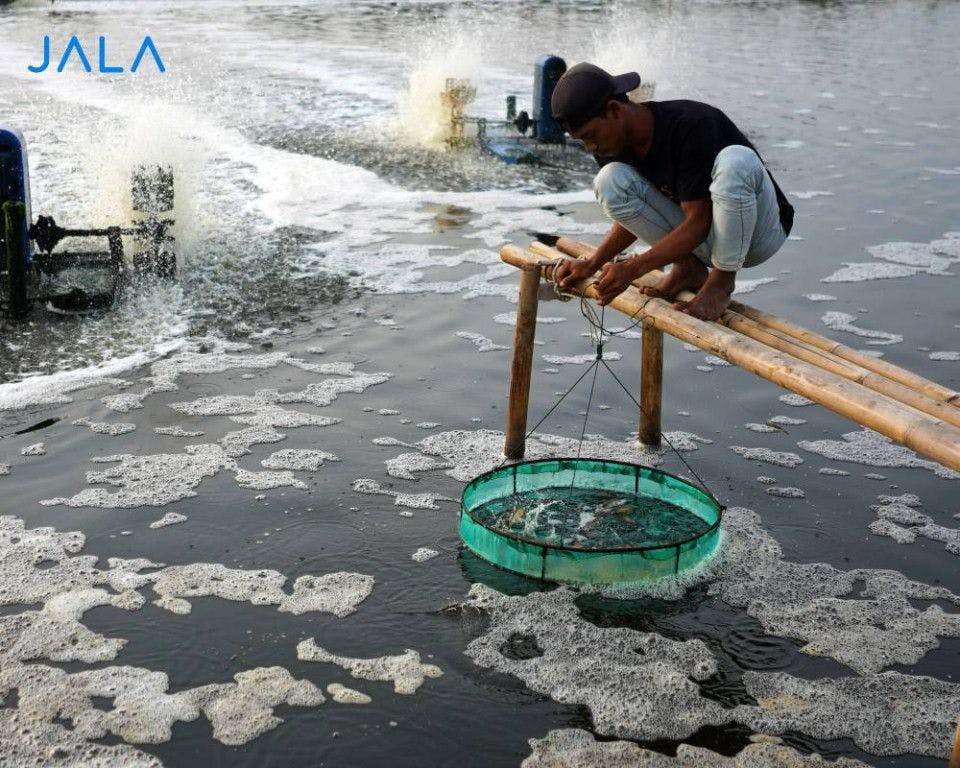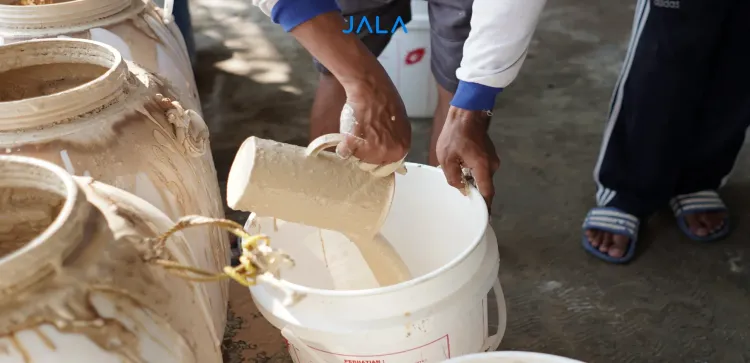
Shrimp cultivation with an intensive system has become a popular trend due to high demand from both local and international markets. However, high stocking density and the use of excessive feed in this system can lead to a decline in water quality if not accompanied by proper water quality management. Therefore, shrimp farmers need to seek effective and efficient solutions in water quality management to increase production without harming the environment. One of the solutions that can be implemented is the use of biofloc technology.
What is biofloc technology?
Biofloc is a biotechnology innovation in aquaculture that utilizes beneficial bacteria to form floc aggregates. These flocs are formed from organic and inorganic matter such as leftover feed, feces, oxygen, hydrogen, nitrogen, and carbon within the cultivation container. The presence of these flocs serves as a protein-rich food source for the cultivated aquatic organisms, optimizing the use of feed more efficiently. Therefore, the use of biofloc in aquaculture can provide dual benefits, improving water quality and increasing feed efficiency.
The application of biofloc technology in intensive cultivation systems has been proven successful for fish species such as tilapia, catfish, and vannamei shrimp. Scientific studies have also demonstrated that the use of biofloc in vannamei shrimp farming can significantly increase the daily growth rate and survival rate. In other words, cultivated shrimp will grow faster, and the harvested shrimp quantity will be greater compared to cultivation systems that rely on routine water exchange during water quality decline. The use of biofloc technology provides an effective solution to enhance efficiency and productivity in intensive shrimp farming.
Floc formation process in biofloc technology
Shrimp can only retain around 16-40% of feed protein, while the rest is excreted as waste in the form of feces and ammonia. This organic waste can be utilized by heterotrophic bacteria such as Paracolobacterium aerogenoids, Bacillus subtilis, and Bacillus cereus to form flocs (bioflocculants). These bacteria consume the cultivation waste as a source of life energy. Simultaneously, these bacteria also produce mucous metabolites and biopolymer molecules that cause the formation of flocs in the water column.
The implementation of biofloc technology is an innovative solution to overcome the challenges in shrimp farming
The shrimp farming industry has been developed in response to high consumer demand. Relying solely on wild-caught shrimp would not be sufficient and could potentially lead to the depletion of shrimp species in their natural habitats. Furthermore, vannamei shrimp, which is a preferred commodity, is not native to Indonesian waters. Therefore, cultivation efforts are necessary to produce a large quantity of shrimp to meet market demands.
In recent years, shrimp farmers in Indonesia have been utilizing biofloc technology in intensive shrimp farming systems. The application of biofloc has been proven both in laboratory and industrial scales to address various challenges encountered during the shrimp farming process, such as growth rate, water quality, feed efficiency and effectiveness, and shrimp health.
In shrimp farming, achieving high growth rates is a primary goal. To accomplish this, it is important to maintain optimal environmental conditions, shrimp health, and the population of pathogens. By using biofloc, cultivation waste can be reduced as bacteria convert it into nutrient-rich flocs. The metabolic activities of the floc-forming bacteria also help suppress the levels of ammonia, which is a harmful waste, thereby reducing environmental stress on shrimp. Shrimp that live in comfortable conditions are essential for optimal growth.
In addition to serving as a bioflocculant, bacteria in the biofloc system have the ability to enhance feed digestibility, resulting in lower feed conversion ratios (FCR) and improved feed retention in shrimp. The floc-forming bacteria also produce active compounds that can suppress populations of pathogenic bacteria, such as Vibrio sp., within the water column. The bacteria present in the flocs can also act as immunostimulants, enhancing the non-specific immune response in shrimp when consumed, thereby improving the shrimp's resistance to diseases and increasing survival rates (SR).
The importance of aeration and water pH in biofloc technology
Biofloc technology requires ample aeration as a source of oxygen to optimize the biological activity of bacteria and shrimp in cultivation ponds. The aeration process also aims to stir organic and inorganic particles, preventing them from settling at the bottom to ensure the flocculation process runs smoothly. The strength of aeration needs to be calculated by considering several factors such as the container size, water volume, C/N ratio value, shrimp biomass weight, and bacterial density in the cultivation container.
Additionally, biofloc also requires stable water pH. In low pH conditions, the flocs are more prone to disintegration as the water lacks divalent cations to form esterase bonds (intermolecular bonds within the floc). Recognizing the importance of stable water pH, regular water monitoring is necessary. Low pH conditions are generally addressed by the application of dolomite or other types of lime to maintain a suitable water pH.
Mutualism in biofloc technology
Based on the explanation above, it is clear that shrimp cultivation using biofloc technology essentially establishes a mutually beneficial relationship between the flocculating bacteria and the cultured shrimp. The shrimp provide food for the bacteria in the form of metabolic waste containing organic matter, while the bacteria form flocs that can serve as a food source for the shrimp. This mutually beneficial relationship is one of the effective and efficient solutions to enhance sustainable and environmentally friendly shrimp cultivation productivity.
Resources:
Probiotics for Biofloc Systems: Harness Beneficial Bacteria | QB Labs
Arsad S, Afandy A, Purwadhi AP, Saputra DK., Buwono NR. 2017. Studi kegiatan budidaya pembesaran udang vaname (Litopenaeus vannamei) dengan penerapan sistem pemeliharaan berbeda. Jurnal Ilmiah Perikanan dan Kelautan. 9(1):1-14. https://dx.doi.org/10.20473/jipk.v9i1.7624
Pantjara B, Nawang A, Usman, Rachmansyah. 2010. Budidaya udang vaname sistem bioflok. Media Akuakultur. 5(2):93-97. http://dx.doi.org/10.15578/ma.5.2.2010.93-97
Biography
The author of this article is Muhammad Dzakwan. Currently, the author is an active college student in the Fisheries Cultivation, Technology and Management program at IPB University. During their time at the university, the author has extensively studied the fields of health, reproduction, genetics, nutrition, and business management related to cultivated aquatic organisms. Additionally, the author is actively involved in a student research organization called the IPB SSRS Association, which focuses on research and publishing scientific journals in the field of Fish & Aquaculture.





